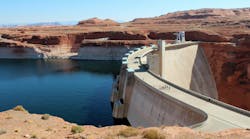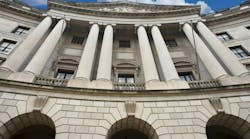The National Pollutant Discharge Elimination System (NPDES) is an important regulatory tool for managing and controlling water pollution from a variety of sources. However, for industrial facilities, NPDES permitting can be a complex regulatory landscape.
In this article, learn how to navigate the regulatory framework behind industrial stormwater management — from permitting authorities to fees, monitoring and beyond.
Types of NPDES permits
NPDES is authorized by the Federal Clean Water Act. Every state and territory is also likely to have its own unique water quality control legislation.
NPDES permits authorize facilities to discharge stormwater into waters of the United States. These permits can be split into three main groups: municipal, construction and industrial.
Industrial NPDES permits can vary widely, as they are tailored to specific industrial activities — as well as to the different states that issue them. Broadly, industrial NPDES permits belong in one of two categories: a general industrial stormwater permit or an individual industrial stormwater permit.
NPDES general permits are appropriate for most industrial activity. General permits can cover facilities that are generally smaller and not too unique. These require less paperwork than individual permits — an industrial facility can navigate the requirements of the permit with relative ease.
NPDES individual permits are issued on a case-by-case basis for activities not covered by the general permit. There are often appropriate for large or complex facilities/sources. This type of permit can often include detailed and site-specific requirements.
Industrial stormwater management depends on location
While the U.S. EPA is the authority behind the core regulatory framework of NPDES permitting, most states administer and enforce their own NPDES programs. Each state can have its own permitting authority, permit application procedures, pollutant regulations, waivers, fees and more.
However, EPA maintains control over minimum federal standards and retains oversight over state NPDES programs, meaning there are some consistent aspects of permitting nationwide.
Because industrial stormwater management can be so dependent on location, it is essential to be aware of state-specific requirements.
NPDES permitting authorities nationwide
Most states have received authorization for components of the NPDES program. For states that are not authorized, however, EPA will generally be the official NPDES permitting authority. For most of these areas, EPA’s Multi-Sector General Permit (MSGP) will apply. According to EPA, the areas covered under MSGP include:
- Three states: Massachusetts, New Hampshire and New Mexico
- The District of Columbia
- Puerto Rico
- All U.S. territories except for the Virgin Islands
- Federally operated facilities in Colorado, Delaware, Vermont and Washington
- Most Indian country lands, and
- Specific designated activities in specific states (e.g., oil and gas activities in Texas and Oklahoma)
EPA provides a table of every state and territory’s NPDES program authority, including links to help find the state’s NPDES permitting webpage. EPA also has a color-coded map that shows the status of NPDES program for each state and territory.
The cost of permitting
The cost and length of permitting varies wildly between states and facilities.
For example, in Iowa, a 1-year general permit can cost $175, while a 5-year general permit can cost $700; in Illinois, a general permit annual fee for industrial sites is generally $500.
Some states depend upon industrial stormwater permit fees to support administrative tasks, while other states may follow a very different funding model.
In addition, the size and type of the facility can influence the price of permitting. Facilities with a history of non-compliance may face higher permit fees, and facilities with higher pollutant discharge levels may see increased fees.
NPDES industrial permit compliance
Most industrial stormwater permits require facilities to conduct self-monitoring and self-reporting.
Self-monitoring is captured through regular sample collection and analysis. The permitted facility will often need to collect samples of stormwater runoff and analyze these samples for specific pollutants, such as total suspended solids, pH, or metals.
The EPA Industrial Stormwater Monitoring and Sampling Guide is a great resource for facilities — especially those operating in areas covered under the MSGP.
Self-reporting often means that the permitted facility must submit regular reports to the permitting authority, detailing the results of monitoring and recording any actions to address pollution incidence. Often, facilities need to provide these reports on a quarterly or annual basis. The regulatory authority can also require the facility to keep records of all the monitoring and reporting performed.
In addition to these requirements, permitted facilities may need to train their employees on stormwater pollution prevention practices. Any records of employee training should be maintained, just like other monitoring or reporting documents.
The regulatory authority might conduct periodic inspections of permitted facilities to verify the facility’s permit compliance. These inspections will often review recordkeeping and observe the facility’s stormwater management practices.
Some authorities, including areas covered under the MSGP, will require industrial facilities to develop and maintain a Stormwater Pollution Prevention Plan (SWPPP). This plan outlines the facility’s stormwater management practices and should be regularly updated.






